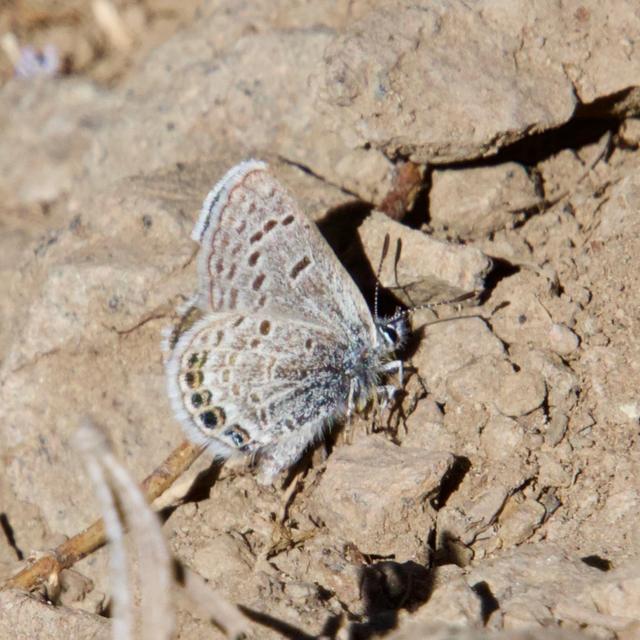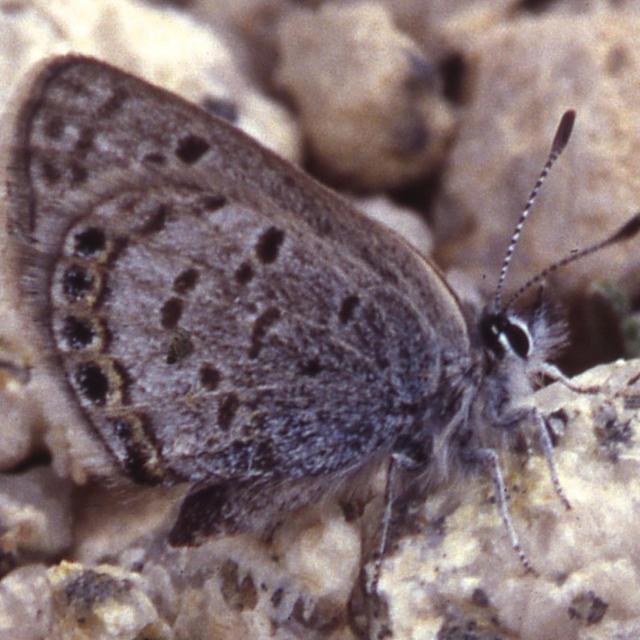National Moth Week is July 20-28, 2024!
Moths are amazing creatures. Take photographs and share your moth sightings with us to document the moths where you live.
Shasta Blue
Plebejus shasta (W.H. Edwards, 1862)
Family: Lycaenidae
Subfamily: Polyommatinae
Identification: Upperside of male lilac blue with a wide dark border; female darker, may have orange band at outer margin of hindwing. Both sexes with dark cell bars on fore- and hindwings. Underside of both sexes gray with black postmedian spots; other spots are dark gray. Hindwing outer margin with iridescent green spots capped by a light band.
Wing Span: 7/8 - 1 1/8 inches (2.2 - 3 cm).
Life History: Males fly just above the ground to search for females. Eggs are laid singly on leaves of host plants; caterpillars feed on leaves and flowers. Where found above timberline, these butterflies require 2 years to mature, spending their first winter as eggs and the second winter as mature caterpillars.
Flight: One brood from June-August.
Caterpillar Hosts: Various Astragalus, Lupinus, and Trifolium species of the pea family (Fabaceae).
Adult Food: Flower nectar.
Habitat: Cushion-plant communities in forest openings, sagebrush hills, high plains, prairies, and alpine fell-fields.
Range: High elevations from Washington east to North Dakota and Nebraska; south to central California and Colorado.
Conservation: Not usually of conservation concern.
NCGR: G5 - Demonstrably secure globally, though it may be quite rare in parts of its range, especially at the periphery.
Management Needs: Not reported.
Comments: NULL
Get your BAMONA Gear!
Please donate!
We depend on donations to keep Butterflies and Moths of North America freely available. We want to express our gratitude to all who showed their support by making a contribution this year. You can donate to support this project at any time.
Advertise with us!
Do you have a product or service that you think would interest BAMONA users? If you would like to advertise on this website, contact us by email, or use the contact form and select the "Advertising" category.
Verified Sightings
Displaying 1 - 24 of 327 verified sightings

Observation date: Aug 29, 2023
Submitted by: Robert Gorman
Region: Mono County, California, United States
Verified by: Ken Davenport
Verified date: Sep 24, 2023

Observation date: Jul 13, 2023
Submitted by: ncrosbyrd
Region: Summit County, Colorado, United States
Verified by: mikefisher
Verified date: Sep 10, 2023

Observation date: Jul 10, 2018
Submitted by: Cheri Phillips
Region: Larimer County, Colorado, United States
Verified by: mikefisher
Verified date: May 29, 2023

Observation date: Jul 04, 2018
Submitted by: Robb Hannawacker
Region: Cache County, Utah, United States
Verified by: RaisingButterfl...
Verified date: Dec 15, 2022

Observation date: Aug 21, 2022
Submitted by: MAKI
Region: Eureka County, Nevada, United States
Verified by: Ken Davenport
Verified date: Oct 13, 2022

Observation date: Sep 09, 2022
Submitted by: dchartier
Region: Summit County, Colorado, United States
Verified by: mikefisher
Verified date: Oct 02, 2022

Observation date: Jul 11, 2021
Submitted by: smasta
Region: Klamath County, Oregon, United States
Verified by: Ken Davenport
Verified date: Dec 31, 2021

Observation date: Jul 31, 2021
Submitted by: bjones7777
Region: Park County, Wyoming, United States
Verified by: J_Martineau
Verified date: Sep 07, 2021

Observation date: Jul 20, 2021
Submitted by: mstanek
Region: Mariposa County, California, United States
Verified by: Ken Davenport
Verified date: Jul 21, 2021

Observation date: Jul 11, 2014
Submitted by: chherrmann
Region: Clark County, Nevada, United States
Verified by: Ken Davenport
Verified date: Jun 14, 2021

Observation date: Jul 25, 2020
Submitted by: papilio1
Region: Washoe County, Nevada, United States
Verified by: Ken Davenport
Verified date: Jul 29, 2020

Observation date: Jun 25, 2019
Submitted by: J_Martineau
Region: Natrona County, Wyoming, United States
Verified by: J_Martineau
Verified date: Dec 04, 2019

Observation date: Jul 28, 2019
Submitted by: A_baldini
Region: Larimer County, Colorado, United States
Verified by: mikefisher
Verified date: Oct 13, 2019

Observation date: Sep 08, 2019
Submitted by: sfbaywildlife
Region: California, United States
Verified by: Ken Davenport
Verified date: Sep 21, 2019

Observation date: Aug 25, 2019
Submitted by: tirvine2020
Region: Teton County, Wyoming, United States
Verified by: J_Martineau
Verified date: Sep 04, 2019

Observation date: Jul 14, 2019
Submitted by: tomoclark
Region: Modoc County, California, United States
Verified by: Ken Davenport
Verified date: Jul 20, 2019

Observation date: Jun 26, 2019
Submitted by: ncrosbyrd
Region: Deschutes County, Oregon, United States
Verified by: Ken Davenport
Verified date: Jul 14, 2019

Observation date: Aug 23, 2008
Submitted by: hydapse
Region: Park County, Wyoming, United States
Verified by: J_Martineau
Verified date: Feb 07, 2019

Observation date: Aug 08, 2018
Submitted by: Robert Gorman
Region: Mono County, California, United States
Verified by: Ken Davenport
Verified date: Aug 20, 2018

Observation date: Jul 15, 2018
Submitted by: Lisahug
Region: White Pine County, Nevada, United States
Verified by: Ken Davenport
Verified date: Aug 03, 2018

Observation date: Jul 12, 2018
Submitted by: Robert Gorman
Region: Sierra County, California, United States
Verified by: Ken Davenport
Verified date: Jul 19, 2018

Observation date: Jul 14, 2018
Submitted by: Robert Gorman
Region: Mono County, California, United States
Verified by: Ken Davenport
Verified date: Jul 18, 2018

Observation date: Aug 06, 2016
Submitted by: coreyk
Region: Mono County, California, United States
Verified by: Ken Davenport
Verified date: Aug 12, 2016

Observation date: Aug 06, 2016
Submitted by: coreyk
Region: Mono County, California, United States
Verified by: Ken Davenport
Verified date: Aug 12, 2016
- 1 of 14
- next ›




